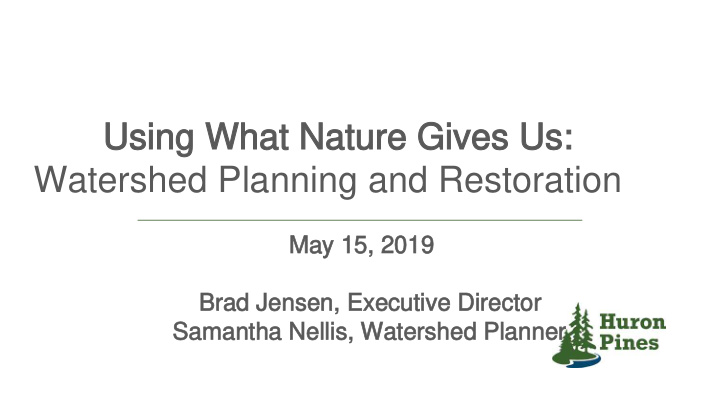



Using What Nature Gives Us: Using What Nature Gives Us: Watershed Planning and Restoration May 15, 2019 May 15, 2019 Brad Jensen, Executive Director Brad Jensen, Executive Director Samantha Nellis, Watershed Planner Samantha Nellis, Watershed Planner
Huron Pines Service Area Huron Pines Service Area Huron Pines was established in 1973 to protect, restore and conserve Michigan’s natural resources. Our work across Northeast Michigan’s forests, lakes and streams improves economic, environmental, educational and recreational opportunities in communities throughout our region.
About our work About our work Healthy Water Protected Places Vibrant Communities
Subwatersheds Subwatersheds Why a watershed approach? Our approach: ● Identify need ● Identify Partners and Collaborators ● Funding ● Characterize watershed ● Plan and Implement ● Community involvement and capacity building
Au Sable Watershed: Early Efforts Au Sable Watershed: Early Efforts
Grayling Stormwater Grayling Stormwater ● Combined Green and Grey Infrastructure ○ 86 rain gardens ○ 7 oil-grit separators ○ 202 acres treated ● Reduction in nutrient, sediments and temperature of water entering Au Sable river; increased groundwater infiltration ● Community Resiliency
Lessons Learned Lessons Learned ● Building community enthusiasm and capacity ● Long-term maintenance ● Tying together green and grey infrastructure ● Helping funders set realistic targets
Rifle River Watershed Rifle River Watershed ● 396 square mile watershed ● Most of the Rifle River and many of its tributaries are designated trout streams ● Drains to Saginaw Bay, an EPA Area of Concern ● West Branch and Rose City are the two largest municipalities
Partnership Approach Partnership Approach
Characterize Watershed Characterize Watershed ● Rifle River Watershed Management Plan ○ Characterize, identify goals and objectives, implementation plan ● Comprehensive natural resources inventories ○ 245 road/stream crossing sites ○ 405 streambank erosion sites ○ 214 Invasive plants incidences ○ 183 agricultural properties
Project Highlights Project Highlights ● Outreach and Education - brochures, mailings, web-based toolkit, interpretive signs, landowner contacts, etc. ● Streambank Restoration - tree revetments, plantings ● Agricultural BMPs ● Road/stream crossings - 11.2 miles reconnected ● Stormwater management
Houghton Creek Houghton Creek ● Replaced undersized culvert with timber bridge ● Reconnected 5 miles of upstream habitat After Before
Stormwater runoff Stormwater runoff West Branch and Rose City
Next Steps Next Steps ● Lake Huron Coastal Communities Stormwater Management ● Road/stream crossing improvements ● Invasive Species ● Educational and Outreach Efforts Samantha Nellis samantha@huronpines.org 989-448-2293 ext. 31
Recommend
More recommend